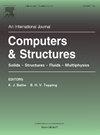Predictive theoretical model for elastic modulus of marine geopolymer concrete: Insights into micro-mesoscopic components and alkaline content effects
IF 4.8
2区 工程技术
Q1 COMPUTER SCIENCE, INTERDISCIPLINARY APPLICATIONS
引用次数: 0
Abstract
Marine geopolymer concrete, recognized for its low-carbon and highly durable properties, garnered considerable attention in ocean engineering applications. Given the lengthy testing and numerous variables in concrete research, developing a theoretical model with clear physical meaning to capture the effects of micro-mesoscopic components and alkaline content on the elastic modulus was essential. Based on multi-scale techniques, this study introduced a three-step homogenization framework to consider the impact of proportion for pores with different sizes on the elastic modulus of the concrete matrix. Then, a single-aggregate concrete was established using a two-phase spherical system, followed by a model incorporating both coral coarse aggregate and normal limestone aggregate via the Effective Medium Approximation. A damage factor was included to account for internal curing effects and matrix shrinkage-induced damage. Seven groups of concrete specimens with different coral coarse aggregate and alkaline contents were tested to validate the accuracy of the model. The model was then employed to thoroughly analyze the effects of total aggregate content, aggregate elastic modulus, aggregate volume fraction, sand ratio, total porosity, effective pore proportion, and alkaline content on concrete’s elastic modulus. The optimal design suggested a coral coarse aggregate volume fraction of 50% and an alkaline content of 5%.
海洋地聚合物混凝土弹性模量的预测理论模型:对细观成分和碱含量影响的见解
海洋地聚合物混凝土以其低碳和高耐用的特性,在海洋工程应用中引起了广泛的关注。考虑到混凝土研究中试验时间长,变量多,建立一个具有明确物理意义的理论模型来捕捉微观细观组分和碱性含量对弹性模量的影响至关重要。基于多尺度技术,引入三步均匀化框架,考虑不同尺寸孔隙比例对混凝土基体弹性模量的影响。然后,使用两相球形系统建立了单骨料混凝土,然后通过有效介质近似建立了包含珊瑚粗骨料和普通石灰石骨料的模型。考虑了内部固化效应和基体收缩损伤,加入了损伤因子。通过对7组不同珊瑚粗骨料和碱含量的混凝土试件进行试验,验证了模型的准确性。利用该模型深入分析了总骨料掺量、骨料弹性模量、骨料体积分数、砂比、总孔隙率、有效孔隙比和碱性含量对混凝土弹性模量的影响。最佳设计建议珊瑚粗骨料体积分数为50%,碱性含量为5%。
本文章由计算机程序翻译,如有差异,请以英文原文为准。
求助全文
约1分钟内获得全文
求助全文
来源期刊

Computers & Structures
工程技术-工程:土木
CiteScore
8.80
自引率
6.40%
发文量
122
审稿时长
33 days
期刊介绍:
Computers & Structures publishes advances in the development and use of computational methods for the solution of problems in engineering and the sciences. The range of appropriate contributions is wide, and includes papers on establishing appropriate mathematical models and their numerical solution in all areas of mechanics. The journal also includes articles that present a substantial review of a field in the topics of the journal.
 求助内容:
求助内容: 应助结果提醒方式:
应助结果提醒方式:


